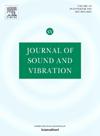Reduced-order analysis and data reconstruction of airfoil turbulent acoustic signals using proper orthogonal decomposition and higher-order dynamic mode decomposition
IF 4.3
2区 工程技术
Q1 ACOUSTICS
引用次数: 0
Abstract
This study employs Higher-Order Dynamic Mode Decomposition (HODMD) and Proper Orthogonal Decomposition (POD) to analyze turbulent flow noise characteristics of a Clark-Y airfoil at Rec = 10⁵. By decomposing sound pressure signals, different frequency, direction, and amplitude components of sound waves are extracted for in-depth acoustic analysis. CFD simulations using LES with the WALE model reveal that laminar separation bubbles form at x/c = 0.28 and reattach at x/c = 0.45, generating a turbulent boundary layer and strong pressure fluctuations, identified as the primary source of low-frequency discrete noise. Modal decomposition and reconstruction of experimental sound pressure data across various angles of attack compare HODMD and POD in handling flow-induced noise. Results indicate HODMD effectively extracts dominant frequencies and high-frequency modal structures, while POD, though efficient in energy decomposition, suffers from mode mixing and lacks interpretability in high-frequency noise scenarios. By integrating Sound Pressure Level (SPL) analysis with HODMD, key frequencies associated with boundary layer transition noise are identified, revealing their time-evolution characteristics. The study highlights HODMD’s superiority in capturing dynamic evolution and stable modes of airfoil noise, providing valuable insights for aeroacoustic noise prediction and control strategies.
采用适当的正交分解和高阶动态模态分解对翼型湍流声信号进行降阶分析和数据重构
本研究采用高阶动态模态分解(HODMD)和适当正交分解(POD)分析了Rec = 10 5处Clark-Y翼型的湍流噪声特性。通过对声压信号进行分解,提取声波的不同频率、方向和幅值分量,进行深度声学分析。利用LES和WALE模型进行的CFD模拟表明,层流分离气泡在x/c = 0.28时形成,在x/c = 0.45时重新附着,形成湍流边界层和强烈的压力波动,被认为是低频离散噪声的主要来源。对不同迎角实验声压数据进行模态分解和重构,比较了HODMD和POD处理流致噪声的效果。结果表明,HODMD能有效地提取主导频率和高频模态结构,而POD虽然能有效地分解能量,但存在模态混叠问题,在高频噪声场景下缺乏可解释性。将声压级(SPL)分析与HODMD相结合,识别出边界层过渡噪声的关键频率,揭示了边界层过渡噪声的时间演化特征。该研究突出了HODMD在捕捉翼型噪声动态演变和稳定模式方面的优势,为气动噪声预测和控制策略提供了有价值的见解。
本文章由计算机程序翻译,如有差异,请以英文原文为准。
求助全文
约1分钟内获得全文
求助全文
来源期刊

Journal of Sound and Vibration
工程技术-工程:机械
CiteScore
9.10
自引率
10.60%
发文量
551
审稿时长
69 days
期刊介绍:
The Journal of Sound and Vibration (JSV) is an independent journal devoted to the prompt publication of original papers, both theoretical and experimental, that provide new information on any aspect of sound or vibration. There is an emphasis on fundamental work that has potential for practical application.
JSV was founded and operates on the premise that the subject of sound and vibration requires a journal that publishes papers of a high technical standard across the various subdisciplines, thus facilitating awareness of techniques and discoveries in one area that may be applicable in others.
 求助内容:
求助内容: 应助结果提醒方式:
应助结果提醒方式:


